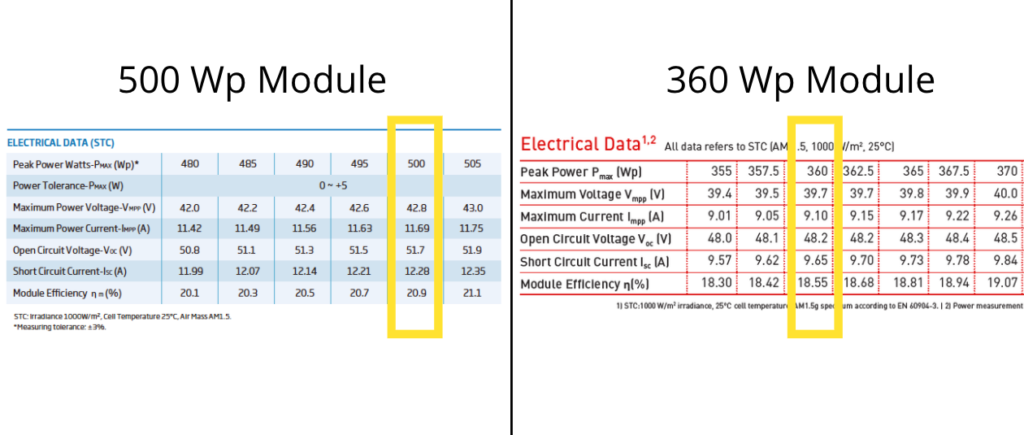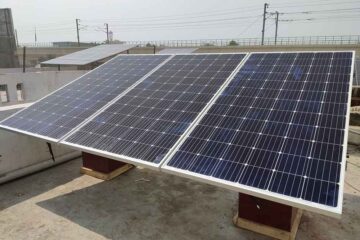As an emerging trend, many solar PV module manufacturers have launched solar PV modules with a higher rated capacity of 500 Wp and above. These modules have higher efficiencies, require less space, and helps in reducing the overall project BOS (Balance of System) costs. This has made it very lucrative for solar PV rooftop EPC companies and most of the companies are now selecting these high-power solar PV modules for their projects.
However, there is a big concern and ambiguity among many EPC players, whether these high power solar PV modules are compatible with the available residential grid-connected inverters in the market or not.
High power solar PV modules
Many manufacturers such as TRINA, LONGI, JA, Canadian, etc. have launched higher rating solar PV modules with rated capacities of 500 Wp and above. These modules have a higher Current (Imp and Isc) and higher Voltage (Vmp and Voc) ratings when compared to previously available modules of lower power ratings such as 350 Wp or so.
The below image shows the electrical data for the 500 Wp and 360 Wp modules. It can be seen that the Current ratings and Voltage ratings of the 500 Wp module are higher than the ratings of the 360 Wp module.

Current Rating Comparison:
500 Wp Module: Imp = 11.69 A & Isc = 12.28 A
360 Wp Module: Imp = 9.10 A & Isc = 9.65 A
Voltage Rating Comparison:
500 Wp Module: Vmp = 42.8 V & Voc = 51.7 V
360 Wp Module: Vmp = 39.7 V & Voc = 48.2 V
Compatibility with available residential grid connected inverters
To check the compatibility of available grid tied inverters with these high power solar PV modules, one needs to match the voltage and current ratings of both.
Voltage matching of high power solar PV modules and available grid connected inverters is not a reason of concern. Since, one needs to select number of modules in a string (series connection) by matching output voltage of solar PV module to the input voltage ranges of the inverter.
However, Current matching is the factor that may limit the compatibility of these high power solar PV modules and available residential grid connected inverters.
Most of the inverter manufacturer’s datasheets show two DC input current ratings:
- Maximum Input Current
- Maximum Input Short Circuit Current
Similarly, solar PV module’s datasheets shows two output current ratings:
- Current at Maximum Power Point (Imp)
- Short Circuit Current (Isc)
Both the current ratings have different meaning and the same need to be understood.
Maximum Input Current of Inverter refers to the actual continuous input current recommended for an optimum energy yield of the system. The inverter will not be able to find the maximum power point if the Current (Imp) of solar PV module is outside the specified range. In this case there may be clipping of power and energy loss would be there in worst condition. However, there will be no damage to the inverter. We recommend you to consult the same with your inverter manufacturer and take their consent before finalising such configurations.
Maximum Input Short Circuit Current of the inverter indicates to the maximum limit outside which inverter may be damaged. So, in any scenario, if the solar PV module’s short circuit current rating exceeds the maximum input short circuit current of the inverter, it can damage the inverter. Maximum Input Short Circuit Current of the inverter should always be greater than module’s short circuit current.
Hence, while selecting the inverter and solar PV module for your solar PV rooftop project, current ratings should be properly checked.
Feel free to write to us in case you have any further addition or suggestion to our article.


1 Comment
Muhammad Adham · February 28, 2022 at 10:58 pm
Hello solarsaarthi
I want to thank you about yiur article .
Then i have a question
If now we have inverter stock which no fit with the the high power solar panel i mean the sc current
And it’s difficult to get the inverter back to manufacture to improve
So in your opinion what we have to do to solve the problem
Is there something we can you or something we can do to solve that